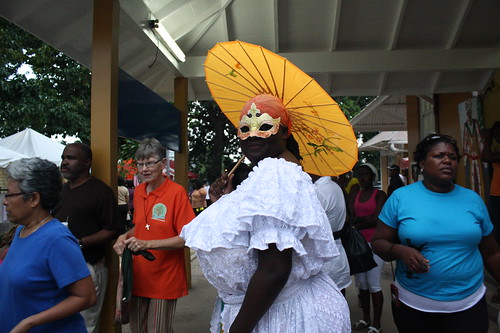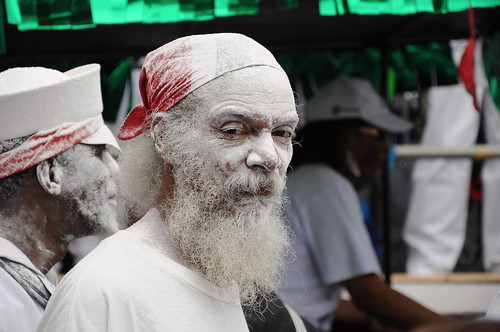I don’t know about you, but I can’t wait for this
weekend. Not because my week was so
stressful (Now that I’ve actually experienced workplace fatigue, burnout, and stress-overload,
nothing can compare to the real thing) nor am I particularly looking forward to
knocking back a few drinks (I tried Puncheon the other day and have decided
that was enough alcohol for at least half a year). No; it’s because this weekend marks the
beginning of my time performing in Trinidad’s carnival under the department of
creative and festival arts. This Sunday
the Performance I class is responsible for the Dame Lorraine portion of the
DCFA’s The Old Yard. At its surface, Dame Lorraine is a showcase
of over-stated Caricatures found in Colonial European societies. All the characters are referred to by their
French Creole names. For instance there
is Misie Gwo Tette; the gentleman with the big head, Madame Gwo Bunda; an aristocratic lady with a
rather large bottom, Madame Tette Fou; a lady left at the altar and who is
therefore constantly hysterical and a bit touched in the head. I will be playing Misie Gwo Coco, a fellow
blessed with the testicles of a hog (anyone who’s ever spent any time around a
pig farm will know what I mean).
Photo by Chioma Ozuzu
The ‘Dame Lorraine has its origins in slavery, like most
other things in Carnival. Of course,
during that time, the Europeans would have their own balls; magnificent,
splendid events which their slaves, of course, were barely allowed to watch,
and certainly not allowed to take part in.
Thus, the slaves held their own balls and parodied their masters,
accentuating the blaring physical deficits in those who held themselves as their
superiors, particularly if they were sort of funny. Thus, the ‘Dame Lorraine Ball is at times
vulgar and at other times quite prim and proper. It is meant to serve as parody, a vicious,
toothy, and truthful parody which still holds to this day. Over time the Dame Lorraine has evolved into
other things; political or social commentary for instance, and the core sentiment colours other types of mas that still
exist. Consider, for instance, the Sailor
Mas: In which men don sailor costume and march, dance, drink, and carouse down
the street, covering themselves in their white powder and occasionally, in a
fit of drunken gaiety, spreading the white disease to bystanders, either by
attacking straight on or by ‘givin’ a lil wine’ whether consensual or not. In this case the parodied slave masters have
been replaced with parodied American and European sailors. Depending on how far back historically one might be
thinking, the idea of exclusion may also be present.
Photo by Kevin Brooks
Exclusion as a driving force in the Dame Lorraine reminds me
of the Belizean Jankunu, borne out of a similar past. The differences in origin seem subtle but
affect the end product significantly.
Slaves in Belize couldn’t simply mock their masters outright and think
to get away with it. If they were to
dance the Jankunu; that is, if they were to mock the ridiculous poses and
rigid, unnatural motions of their masters at their Balls, they would have to do
so as anonymously as possible, lest the master, or a particularly traitorous
Johnny Jumper or Straw Boss see and punish them. Punishment, in our case, didn’t necessarily
mean that you would be flogged or stretched or burned in hot oil or any of the
usual tortures of slavery. In the case
of a forestocracy, where the men were
away from their homes for the better part of the year, punishment meant that
your family would starve while you were away.
Your children would be tortured.
Or perhaps you would leave for the forest and arrive ten months later to
find your wife eight months pregnant, and eventually giving birth to a
curiously light-skinned child. So, in an effort to ensure this anonymity, the
Jankunu dancers are fully covered head to toe, with no space for a uniquely
shaped scar or burn mark to be seen.
Their faces were sieved or cloth masks, on which rosy cheeked and red
lipped European faces were painted on in static expressions. It also follows that the dancers could not
use their voices, so whereas the Dame Lorraine performers take on the persona completely,
interacting with the crowd as Misie Gwo Lolo (Big Penis) and Madam Gwo Pitat
(Big Vagina), the Jankunu dancers react only to the drums. It is, in truth, a dance: A manipulation of
the body in conjuction with music in order to portray an idea. The
fact that a Performance I class can portray the Dame Lorraine characters speaks
to the versatility of the style and concept.
Perhaps this is why there’s been very little conscious development to
the Jankunu over the years. To be
performed properly, the dance requires years of training and physical
conditioning that can only be described as athletic.
(NB: Tony Rath, photographer extrodinaire, has a collection of photos from a Jankunu Festival that illustrate what I'm talking about. However, he's also done the smart thing and locked down use of those photos. You can view them here: http://www.flickr.com/photos/trphoto/sets/72157625756682414/with/5327834227/ but I'll respect his wishes and not insert the photos in this blog.)
I will admit, however, that my knowledge of the Dame Lorraine
is still considerably limited. I only
know what’s happening in this class. It
could be there is a real Dame Lorraine
Ball available somewhere; one with rigid choreography and considerably better
costuming than we can pull together in a few weeks. It could also be that there’s a lot more to
the concept than I’ve been able to piece together. It’s also possible that my idea of the
Jankunu is completely different than the traditionally held idea of it. They told us not to do this though; this
making-excuses-for-the-things-we-write thing.
It’s what I see, and therefore it’s what I’ll be sharing. If, however, you can offer some other
insight, Dear Reader, I welcome it fully.
This is a fascinating aspect of our shared, regional culture. Come, let’s explore some.

